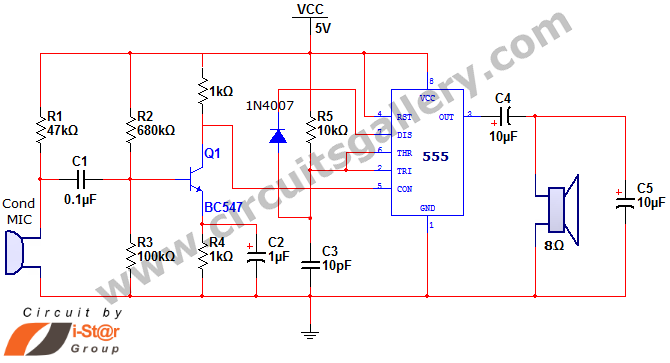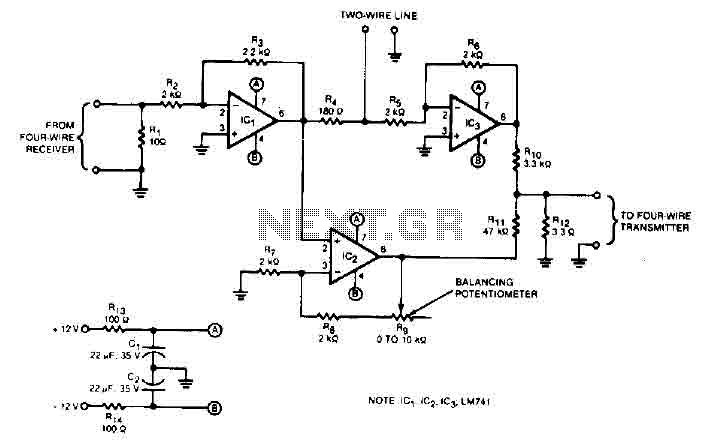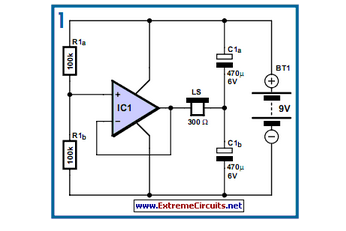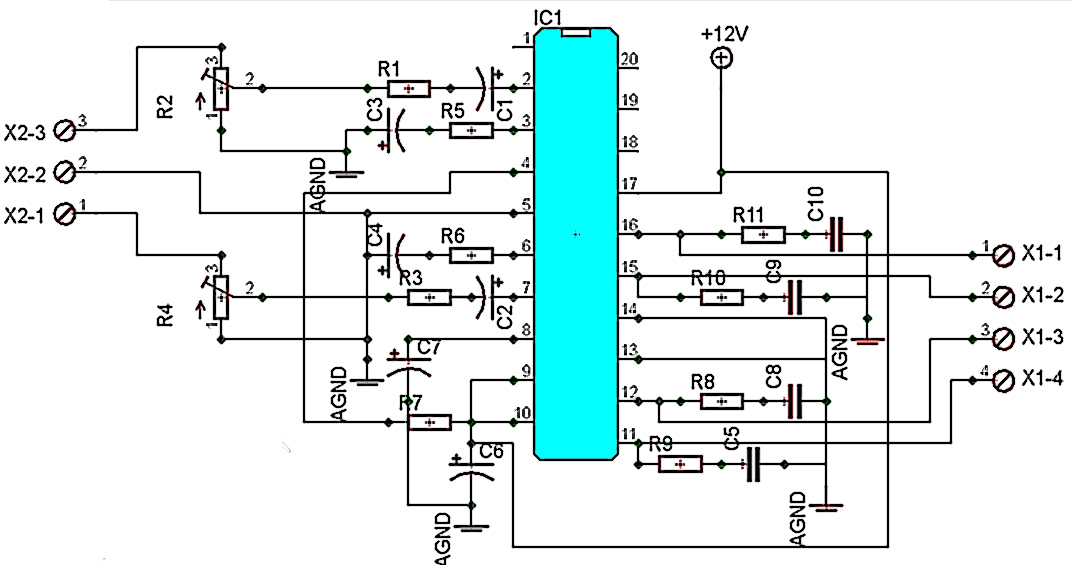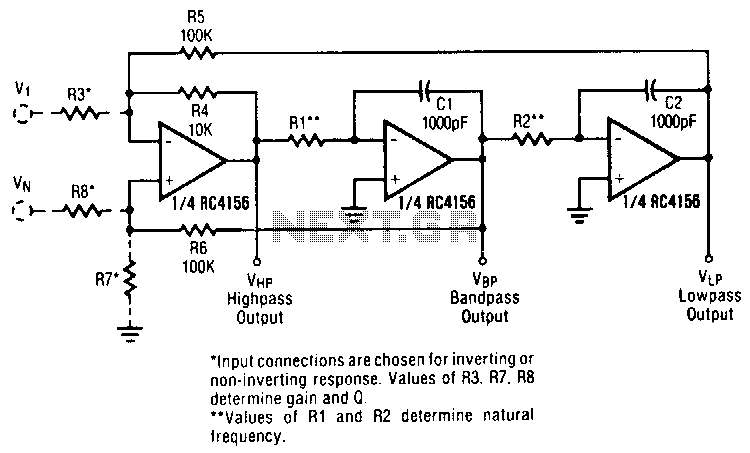
audio bandpass filter
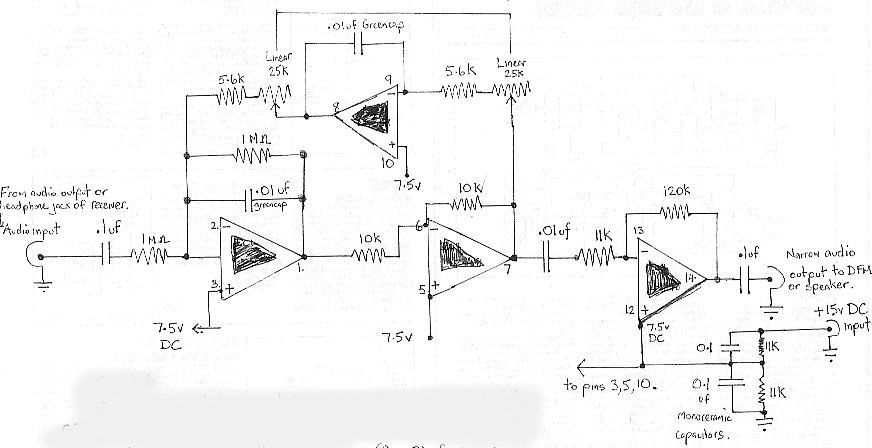
The audio bandpass filter described is beneficial for amplifying and filtering weak AM TV video carriers. For instance, a digital frequency audio multimeter (DFM) may lack sufficient input sensitivity for measuring extremely weak single sideband (SSB) TV video audio signals. Utilizing a 20 Hz filter to enhance the desired carrier allows the DFM to accurately display the carrier frequency. Another application of this filter includes increased amplification and reduced bandwidth for weak broadcast band (BCB) heterodyne AM carriers. The filter is effective in separating video carriers that are closely spaced. By definition, a bandpass filter consists of a low-pass and high-pass filter in series, permitting only a specific range of frequencies to pass through. Due to the proximity of the cut-off frequencies, the filter behaves similarly to a peaking filter. When peaked, the filter's bandwidth is approximately 20 Hz, which is significantly narrower than the typical 2.4 kHz SSB bandwidth found in most communications receivers. The key advantage of this filter is the consistent 20 Hz bandwidth, irrespective of the resonant frequency, when adjusted between 400 Hz and 4000 Hz. The audio line-out or headphone output from a VHF/UHF scanning or communications receiver connects to the input of the bandpass filter. The output from the filter is linked to a digital frequency meter (DFM) or an audio monitor speaker. A monitor speaker is utilized for fine-tuning the filter's resonant frequency. In the absence of a DFM, a PC program like Spectrum Lab can be employed for spectral display of TV video carriers on a computer screen. The filter's tuning range extends from approximately 400 Hz to 4 kHz when using a 50 kΩ potentiometer. The typical tuning frequency is around 1000-1300 Hz, which corresponds to the maximum output level in 2.4 kHz upper sideband (USB) mode. A 10 kΩ fine-tuning potentiometer can also be added in series with the main 50 kΩ potentiometer, enhancing the tuning range from 300 Hz to 1000 Hz and improving the bandspread by a factor of four up to 2 kHz. This fine-tuning potentiometer is particularly useful for receivers with a minimum tuning step of 100 Hz, such as the Icom R7000/7100/8500 models. Initially, an LM348 operational amplifier was utilized in the circuit. Although it performed adequately, replacing the LM348 with an LM6134BIN integrated circuit resulted in improved high-frequency response.
The audio bandpass filter design focuses on effectively amplifying and filtering specific frequency ranges to enhance the performance of various audio and video applications. The filter's architecture combines both low-pass and high-pass filtering capabilities, allowing for selective frequency transmission while attenuating unwanted signals outside the designated bandwidth. The filter's narrow bandwidth of approximately 20 Hz is particularly advantageous for applications requiring precise frequency discrimination, such as in the reception of weak AM video carriers, where signal clarity is crucial.
The integration of a digital frequency audio multimeter (DFM) or audio monitor speaker at the output stage facilitates real-time monitoring and adjustment of the filter's performance. This enables users to optimize the filter settings to achieve the best possible signal quality. The option to utilize software tools like Spectrum Lab provides additional flexibility for visualizing the frequency spectrum, aiding in the identification and separation of closely spaced video carriers.
The tuning mechanism of the filter, utilizing a 50 kΩ potentiometer, offers a broad adjustment range, allowing for precise resonance tuning within the specified frequency limits. The addition of a fine-tuning potentiometer further enhances the filter's versatility, making it suitable for various receivers with differing tuning capabilities. The transition from the LM348 to the LM6134BIN operational amplifier marks a significant improvement in the filter's high-frequency response, ensuring that the filter can handle a wide spectrum of audio frequencies effectively.
In summary, this audio bandpass filter serves as a critical component for applications involving weak AM TV video carriers, providing both amplification and filtering capabilities while maintaining a narrow bandwidth for optimal signal processing. Its design allows for user customization and adaptability, making it a valuable tool for audio and video signal analysis.The audio bandpass filter described is useful for amplification and filtering weak AM TV video carriers. For example, a DFM (digital frequency audio multimeter) may have insufficient input sensitivity for measuring extremely weak SSB TV video audio signals.
By using the 20 Hz filter to peak the wanted carrier, the DFM will display the carrier freq uency. Another possible application for this filter is increased amplification and reduced bandwidth of weak BCB heterodyne AM carriers. The filter is also very useful for separating video carriers that are in close proximity of each other.
By definition, a bandpass filter is usually a low-pass and high-pass filter in series, allowing only a certain range of frequencies through. Because the cut-off frequencies are close to one another, the effect will be similar to that of a peaking filter.
The bandwidth of the filter, when peaked is approximately 20 Hz. This is much narrower than the typical 2. 4 KHz SSB bandwidth of most communications receivers. The advantage of this filter is a constant 20 Hz bandwidth, regardless of the resonant frequency, when peaked between 400-4000 Hz. The audio line-out or headphone output from a VHF/UHF scanning or communications receiver is connected to the input of the bandpass filter.
The output of the bandpass filter is connected to a digital frequency meter (DFM), and/or audio monitor speaker. A monitor speaker is used when tweaking the filter`s resonant frequency. If a DFM is not used, a PC program, such as Spectrum Lab could be used for spectral display of TV video carriers on a computer screen.
The tuning range of the filter is from ~ 400 Hz to 4 KHz, when using a 50 KHz potentiometer. The writer typically tunes the filter to resonate around ~ 1000-1300 Hz. This frequency range corresponds to the maximum output level of 2. 4 KHz USB mode. A 10K fine tuning potentiometer has also been added (not shown on the schematic). This can be included in series with the main 50K pot. I did this on my filter, and the centre of the tuning range moved from 300 Hz to 1000 Hz and improved the bandspread by a factor of about 4 times up to 2 kHz. A fine tune pot is useful for use with receivers that have 100 Hz minimum tuning steps, for example, Icom R7000/7100/8500, etc.
Initially, a LM348 op-amp was used in the circut. Although this worked ok, it was found that by replacing the LM348 with a LM6134BIN IC, improved high frequency response was obtained. 🔗 External reference
The audio bandpass filter design focuses on effectively amplifying and filtering specific frequency ranges to enhance the performance of various audio and video applications. The filter's architecture combines both low-pass and high-pass filtering capabilities, allowing for selective frequency transmission while attenuating unwanted signals outside the designated bandwidth. The filter's narrow bandwidth of approximately 20 Hz is particularly advantageous for applications requiring precise frequency discrimination, such as in the reception of weak AM video carriers, where signal clarity is crucial.
The integration of a digital frequency audio multimeter (DFM) or audio monitor speaker at the output stage facilitates real-time monitoring and adjustment of the filter's performance. This enables users to optimize the filter settings to achieve the best possible signal quality. The option to utilize software tools like Spectrum Lab provides additional flexibility for visualizing the frequency spectrum, aiding in the identification and separation of closely spaced video carriers.
The tuning mechanism of the filter, utilizing a 50 kΩ potentiometer, offers a broad adjustment range, allowing for precise resonance tuning within the specified frequency limits. The addition of a fine-tuning potentiometer further enhances the filter's versatility, making it suitable for various receivers with differing tuning capabilities. The transition from the LM348 to the LM6134BIN operational amplifier marks a significant improvement in the filter's high-frequency response, ensuring that the filter can handle a wide spectrum of audio frequencies effectively.
In summary, this audio bandpass filter serves as a critical component for applications involving weak AM TV video carriers, providing both amplification and filtering capabilities while maintaining a narrow bandwidth for optimal signal processing. Its design allows for user customization and adaptability, making it a valuable tool for audio and video signal analysis.The audio bandpass filter described is useful for amplification and filtering weak AM TV video carriers. For example, a DFM (digital frequency audio multimeter) may have insufficient input sensitivity for measuring extremely weak SSB TV video audio signals.
By using the 20 Hz filter to peak the wanted carrier, the DFM will display the carrier freq uency. Another possible application for this filter is increased amplification and reduced bandwidth of weak BCB heterodyne AM carriers. The filter is also very useful for separating video carriers that are in close proximity of each other.
By definition, a bandpass filter is usually a low-pass and high-pass filter in series, allowing only a certain range of frequencies through. Because the cut-off frequencies are close to one another, the effect will be similar to that of a peaking filter.
The bandwidth of the filter, when peaked is approximately 20 Hz. This is much narrower than the typical 2. 4 KHz SSB bandwidth of most communications receivers. The advantage of this filter is a constant 20 Hz bandwidth, regardless of the resonant frequency, when peaked between 400-4000 Hz. The audio line-out or headphone output from a VHF/UHF scanning or communications receiver is connected to the input of the bandpass filter.
The output of the bandpass filter is connected to a digital frequency meter (DFM), and/or audio monitor speaker. A monitor speaker is used when tweaking the filter`s resonant frequency. If a DFM is not used, a PC program, such as Spectrum Lab could be used for spectral display of TV video carriers on a computer screen.
The tuning range of the filter is from ~ 400 Hz to 4 KHz, when using a 50 KHz potentiometer. The writer typically tunes the filter to resonate around ~ 1000-1300 Hz. This frequency range corresponds to the maximum output level of 2. 4 KHz USB mode. A 10K fine tuning potentiometer has also been added (not shown on the schematic). This can be included in series with the main 50K pot. I did this on my filter, and the centre of the tuning range moved from 300 Hz to 1000 Hz and improved the bandspread by a factor of about 4 times up to 2 kHz. A fine tune pot is useful for use with receivers that have 100 Hz minimum tuning steps, for example, Icom R7000/7100/8500, etc.
Initially, a LM348 op-amp was used in the circut. Although this worked ok, it was found that by replacing the LM348 with a LM6134BIN IC, improved high frequency response was obtained. 🔗 External reference
Warning: include(partials/cookie-banner.php): Failed to open stream: Permission denied in /var/www/html/nextgr/view-circuit.php on line 713
Warning: include(): Failed opening 'partials/cookie-banner.php' for inclusion (include_path='.:/usr/share/php') in /var/www/html/nextgr/view-circuit.php on line 713

